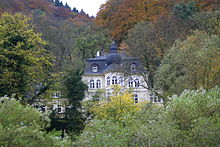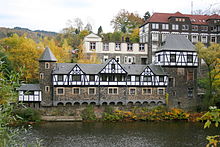Gustav Selve
Gustav Selve (born February 28, 1842 in Lüdenscheid ; † November 7, 1909 in Bonn ) was a German entrepreneur . Before the First World War, he was one of the most important industrialists in Germany, introduced social benefits for the workers he employed at an early stage and is considered one of the pioneers of modern social security , which was later enshrined in law by Otto von Bismarck .
family
Gustav Selve was born in Lüdenscheid in 1842 as the eldest son of the farmer and mill owner Hermann Dietrich Selve (1813–1881) and his wife Anna Katharina (née Selve) (1813–1868) on their estate Peddensiepen near Honsel . He had two brothers and two sisters.
On September 10, 1872 he married Maria Fischer (* May 9, 1853; † 1929), a daughter of the Lüdenscheid factory owner and politician Heinrich Fischer (1825–1890). The marriage resulted in two daughters and two sons, one of whom, however, died young. Two years after the wedding, he and his family moved into a villa on Lüdenscheider Straße in Altena, which the people of Altena also called Villa Alpenburg due to the elaborate design . Today it stands as Gustav Selve Palace under monument protection .
Entrepreneurial activity
Gustav Selve attended the trade school in Iserlohn . He then worked initially for the Caspar Noell copper and brass rolling mill in Lüdenscheid.
Gustav Selve's father founded the brass rolling mill Basse & Selve in Bärenstein near Werdohl together with the manufactured goods dealer Carl Basse in 1861, where the son worked from then on. In 1872 he became a partner and managing director , from 1883 after the withdrawal of the Basse family he was the sole owner of the company, whose headquarters had been relocated to Altena in 1869 .
With the aluminum casting , a material was developed that was used for automobile, motorboat and airship parts. With the production of nickel silver sheet for cartridge cases, nickel for coin plates and brass (alloy of copper and zinc) for fittings of all kinds, the company Basse & Selve employed up to 2,400 people in Altena alone and up to 3,500 people worldwide.
In 1895 he founded the company Schweizerische Metallwerke Selve & Co. in Thun in the Swiss canton of Bern .
Social and political engagement
The area of welfare and the care for the social situation of his workers took up a lot in Gustav Selve's life. The creation of workers' housing, schools for small children and handicrafts, consumption and bathing establishments as well as the establishment of a support fund for those in need are just a few of the institutions he set up. The foundation of Altenaer Baugesellschaft (ABG) in February 1870 was largely due to his commitment. His motto was loyalty for loyalty .
He was a member of the Presidium of the Central Office for Combating Tuberculosis and in 1897 donated 100,000 marks for the construction of a lung sanatorium. On August 1st, 1898, the people's sanatorium for lung patients in the Altena district was opened in Lüdenscheid- Hellersen as the first such facility in the province of Westphalia .
Politically, Gustav Selve was nationally conservative and an ardent admirer of the German Emperor and the Imperial Chancellor Otto von Bismarck . Before Reichstag elections, he instructed his workers, who made up a fifth of the Altena population, which party to vote for, and they followed the advice of the employer. In 1895 he donated 11,000 marks for a Bismarck statue on Lüdenscheider Straße in Altena, directly opposite in the Villa Alpenburg, where he lived . The 2.65 m high statue made of bronze was cast from a model by the sculptor Arnold Künne and unveiled on September 1, 1895. The memorial was dismantled and melted down for armaments purposes during World War II.
From 1885 Gustav Selve was a city councilor in Altena. The city council was elected according to the three-class suffrage . Due to his extraordinarily high income, Selve was temporarily in the first class alone and was able to determine a third of the city councilors. Because of this, he was often referred to as King of Altena , half jokingly .
Departure from Altena and death
Due to the emissions from its production facilities, conflicts arose with the city of Altena and its population. Above all, the nickel smelter in the Schwarzenstein plant impaired agriculture and horticulture in its vicinity with harmful, sulfur-containing emissions, which is why there were more protests from local residents.
Selve also came increasingly into conflict with the city's entrepreneurs. Since he paid his workers relatively high wages and offered exceptional social benefits for the time, he increased the competition for labor considerably in the eyes of local competitors. The Altenaer retailers also saw strong competition in the consumer establishment operated by Selve for his workers.
In the administration of the city of Altena, Selve, who has a stronger communal social commitment, e.g. B. in social housing called for resistance. Ultimately, a dispute with the city's magistrate was decisive for his departure from Altena . Selve had an above-ground power line laid from his Hünengraben plant to his Villa Alpenburg on Lüdenscheider Strasse, which was met with protests from residents who saw it as a disfigurement of the street. Although Selve had previously obtained a building permit, after a dispute over several open letters that were published in the local newspapers, the city administration ordered that Selve had to dismantle the power line.
In 1896 Selve finally left Altena and first moved to Bad Honnef . In 1899 he moved to Bonn , where he had acquired the Villa Martius on the banks of the Rhine , which he had expanded to include a garden hall. The villa was located in the Gronau district in the center of today's landscape park between Villa Loeschigk, which was later called Palais Schaumburg , and Villa Hammerschmidt . His immediate neighbors here were Prince Adolf zu Schaumburg-Lippe and his wife Princess Viktoria of Prussia , a daughter of Emperor Friedrich III. and sister of Kaiser Wilhelm II. Gustav Selve also continued to run his Sauerland company from Bonn. The Altenaer Villa Alpenburg remained in the family's possession.
Selve died in his Bonn villa on November 7th, 1909. His ashes were buried in the Evangelical Cemetery in his native Lüdenscheid, where Gustav Selve had a mausoleum built as the family's hereditary burial as early as 1893 .
At the time of his death, he had built the factory he had taken over from his father into a multinational corporation. He owned factories in Altena, Hemer , Lüdenscheid, as well as production facilities in the Rhineland, Saxony, East Prussia, Switzerland and Italy. In the end, his annual income was estimated at 1.6 million marks. (A worker in Selves earned about 1,000 marks a year.) In 1909 he was 33rd on a list of the richest inhabitants of Prussia .
The group was continued by his son Walther von Selve . In 1921 Basse & Selve was converted into a public limited company. This later became the United Deutsche Metallwerke AG (VDM) (later ThyssenKrupp VDM ).
Honors
- In 1888 Gustav Selve was appointed to the Council of Commerce and in 1897 to the Privy Council of Commerce.
- In 1909 he was awarded the Royal Crown Order, 3rd class.
- The employees of his Altena factories thanked him with the erection of the Gustav Selve monument (popularly known as the silent Gustav ) in Altena am Berg between Lenne and Rahmedetal, which is still in good condition today .
- Gustav-Selve-Straße in Altena and Selvestraße in Hemer are named in his honor.
literature
- Basse & Selve, Altena i. W. Development and history of the company. Festschrift for the celebration of the 50th anniversary 1861–1911. Meisenbach & Riffarth , (Berlin-) Schöneberg, undated (1911).
- Ralf Stremmel: Gustav Selve. Approaches to a large industrialist and economic citizen of the Brandenburg region in the German Empire. In: Der Märker, regional history journal for the area of the former Grafschaft Mark and the Märkische Kreis ( ISSN 0024-9661 ), Altena 2002, pp. 5–20.
- Eckhard Trox: Triumph of the luxury class. Selve, Maybach and the engine building traditions in the south of Westphalia. Lüdenscheid 2004, ISBN 3-929614-51-0 .
- Kulturring Altena (Ed.): But please forward, forward! The Selve family of entrepreneurs. Altena 2006.
- Ralf Stremmel: Selve, Gustav. In: New German Biography (NDB). Volume 24, Duncker & Humblot, Berlin 2010, ISBN 978-3-428-11205-0 , p. 231 f. ( Digitized version ).
Web links
Individual evidence
- ↑ a b c d e f g h Ralf Stremmel: Selve, Gustav. In: New German Biography (NDB). Volume 24, Duncker & Humblot, Berlin 2010, ISBN 978-3-428-11205-0 , p. 231 f. ( Digitized version ).
- ↑ a b c d e f Ralf Stremmel: Gustav Selve. A major industrialist in the German Empire. In: Der Reidemeister, history sheets for Lüdenscheid city and country , No. 180 (from November 3, 2009), pp. 1481–1486.
- ^ A b Ulrich Barth: The monument to the industrialist Gustav Selve (1842–1909) in Altena. In: Preservation of monuments in Westphalia-Lippe ( ISSN 0947-8299 ), year 2007, issue 1, pp. 24-27. ( online as PDF file; 1.37 MB)
- ↑ http://www.beoberland.ch/selve/report.html
- ↑ Sieglinde Seele : Lexicon of Bismarck Monuments. Michael Imhof Verlag, Petersberg 2005, ISBN 3-86568-019-4 .
- ^ Olga Sonntag: Villas on the banks of the Rhine in Bonn. 1819-1914. Volume 2, Catalog 1, Bouvier Verlag, Bonn 1998, ISBN 3-416-02618-7 , pp. 351-361.
| personal data | |
|---|---|
| SURNAME | Selve, Gustav |
| BRIEF DESCRIPTION | German entrepreneur |
| DATE OF BIRTH | February 28, 1842 |
| PLACE OF BIRTH | Lüdenscheid - Peddensiepen |
| DATE OF DEATH | November 7, 1909 |
| Place of death | Bonn |




